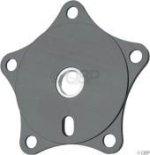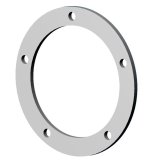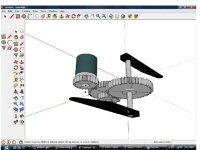There are tons of cog and freewheel choices for the ISO 1/375" 24 TPI version, so why not just pick that for the 1/2" adapter?
Getting back to the freewheel crank version, what about doing an aluminum adapter plate that would go from a standard 130mm or 110mm BCD, down to a hole that would fit over an ENO 22T FW that could be used with trials cranks? That would eliminate the need for having to drill out the Cheese Monkey adapter shown below:

I have a 3rd folding bike, which is a Dahon 16" Curve D3 that has a 3-speed SRAM hub (similar to the Nexus-3, but with slightly different ratios...) that I'm thinking of going the modified crank route with, using a single-stage eDrive and my Hacker A60-18L. There's not much room for a series drive option, which is why I'm looking at the modded crank route.
The Hacker should work out fine with a single belt drive reduction of around 6:1. On the eDrive output shaft, I can use an 11T cog on one of these FW adapters, and then drive a 56T chainring. Without changing the existing 44T/13T front-to-back pedal setup, it should still provide enough reduction that the torque level is pretty high in low. I don't care about what the top-end does, as I'll never get there on something this size, but my spreadsheet model says top speed in 1st (using 50V as the max, and with the motor kV of 149...) will be about 24-25 mph, 32-33 mph in 2nd and 43-44 mph in 3rd. By comparison, on my current 20" Cyclone 1000W 50V setup, which actually has too much low-end torque, the top speeds are about 20-21, 28-29 and 38-39 mph, respectively.
Using the Hacker, with the crank drive, actually brings me full-circle, in a way. My very first ebike build attempt was actually using this same Hacker with a simple drive reduction, based on using large RC helicopter parts. Here's what it looked like:
I mounted the whole assembly on the downtube on my Townie 21, using the water bottle mounts. I set the front deraileur to use the middle chainring, and then drove the largest one from the motor. This setup didn't las long, however, as at the time I didn't know enough about how the freewheel setups work to know that I needed one on the front crankset. The pedals moved with the motor. Also, like the Cyclone setup, this was pretty noisy (small motor sprocket/chording problem...), and as soon as I put a big load on it, the glass-imprgenated hard plastic gear was stripped clean.

Anyway, after this "learning" experience, I got into big Clyte hub motors. Now, along with many here, I'm ready to revisit making use of highly efficient RC-based setups in much lighter ebike setups.
-- Gary






